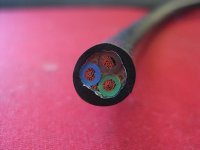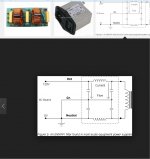Advantages of Power Cords with braided Shield for high Power Solid State Power Amps
Until now I haven't find out the benefits in respect of the sonic performance from such kind of power cords.
Additional there rises up the question, where to connect the shield in cases, where the power cord consist only of two poles (as usual by the use of encapsulated (potted) transformers.
Thank you very much for posting of URLs in this case.
Here is a do-it-yourself description of such a cable:
DIY Belden 83803 Mains Power Cable - Audiophile Power Cord
Until now I haven't find out the benefits in respect of the sonic performance from such kind of power cords.
Additional there rises up the question, where to connect the shield in cases, where the power cord consist only of two poles (as usual by the use of encapsulated (potted) transformers.
Thank you very much for posting of URLs in this case.
Here is a do-it-yourself description of such a cable:
DIY Belden 83803 Mains Power Cable - Audiophile Power Cord
There may be a reason for that.Until now I haven't find out the benefits in respect of the sonic performance from such kind of power cords.
Advantages of Power Cords with braided Shield for high Power Solid State Power Amps
DIY Belden 83803 Mains Power Cable - Audiophile Power Cord
What contradiction !
At the end ....
He is aware that there is no science to back up the need , but "believes" he
needs shielded cables ??
Since he is "aware" that he has no control over the miles of AC transmission
before his cable , why not just filter for RF/common mode inside the amp ?
PS - the cables ARE aesthetic.
OS
I look at it the other way around, its not to keep noise out of the mains cables, but to keep the 50hz mains noise in. In an ideal world you would keep all your interconnects and power cables separated, but in reality most of us have a mess of spaghetti at the back of our hifi racks, prevention is better than a cure and all that.
Personally i use Belden 19364 for mine..
Personally i use Belden 19364 for mine..
Attachments
What about the 100's of meter's of house wiring ... shield that ?
Will that last meter really count ?
Internal cancellation of induced AC , proper grounding = silence.
Only the input pair noise remains - any power cord.
But then , you would not have that 50/60hz "poor man's audio test" at your fingertips.
Edit - back in the analog TV days .... remember -
"turn your whole house wiring system into an
antennae" devices.. They actually worked really well !!
OS
Will that last meter really count ?
Internal cancellation of induced AC , proper grounding = silence.
Only the input pair noise remains - any power cord.
But then , you would not have that 50/60hz "poor man's audio test" at your fingertips.
Edit - back in the analog TV days .... remember -
"turn your whole house wiring system into an
antennae" devices.. They actually worked really well !!
OS
Last edited:
Try it. Run something like RMAA and hold an interconnect against a regular power cable vs a shielded one and you will see a big difference around 50hz. I also found those wall cable locating tools cant see the Belden cable at all so the shielding does work.
I find it surprising how everybody accepts the concept of twisting power cables to prevent pickup and good practices for locating power transformers and chokes inside enclosures, and even shielded interconnects. But mention power cables and all of a sudden its snake oil?
I find it surprising how everybody accepts the concept of twisting power cables to prevent pickup and good practices for locating power transformers and chokes inside enclosures, and even shielded interconnects. But mention power cables and all of a sudden its snake oil?
Try it. Run something like RMAA and hold an interconnect against a regular power cable vs a shielded one and you will see a big difference around 50hz. I also found those wall cable locating tools cant see the Belden cable at all so the shielding does work.
I find it surprising how everybody accepts the concept of twisting power cables to prevent pickup and good practices for locating power transformers and chokes inside enclosures, and even shielded interconnects. But mention power cables and all of a sudden its snake oil?
How many dB are we talking about? I've not had a pickup problem on interconnects before but interested in the scales you are talking about.
Shielded cable = 1% of the problem
99% (In the 21'st century) , is the RFI in our "modern world" AC.
I'll spend $$ (wisely- below) on a filter. I can't clean up after all
the SMPS's and CFL's thrust upon me .... except for after the
AC input of my audio electronics.
PS - looks like fun to make one , after looking at my
, after looking at my
typical in-house AC waveform - a tangible endeaver.
Edit ..... shielding the actual audio against 50/60hz and RFI is a different story.
(input LPF's , cabling , - ground loop issues)
OS
99% (In the 21'st century) , is the RFI in our "modern world" AC.
I'll spend $$ (wisely- below) on a filter. I can't clean up after all
the SMPS's and CFL's thrust upon me .... except for after the
AC input of my audio electronics.
PS - looks like fun to make one
typical in-house AC waveform - a tangible endeaver.
Edit ..... shielding the actual audio against 50/60hz and RFI is a different story.
(input LPF's , cabling , - ground loop issues)
OS
Attachments
Last edited:
I think it may cut down capacitive coupling induced noise within a system that has high impedance unshielded interconnections that laid next to that power cord. But then unshielded cables such as home made "high-end" one in twisted pair style, should never be used in high impedance interconnections in the first place. Otherwise I see that shield over the power cord useless unless it gets hooked up on both ends to reenforce the earth conductor.
I have seen an SMPS fed with a shielded mains cable, but that is to prevent its own emitted rf from being fed back through the mains conductors.
Gajanan Phadte
No, it's the AC input common mode /RFI filter that shields the mains from the "garbage" ....not a shielded cable.
Every PC SMPS has one right at the main AC input.
On the DC side to the SMPS , the quality of the inductors and HF decoupling keeps
this same "garbage" out of the amp .
You will also see these on the DC side of a PC SMPS , as well.
All the cheap CFL and mobile smps's has little or no filtering. This stuff "rides"
right along with primary 50/60hz waveform ... no cable will stop it !
OS
Maybe... the cable will have a slight effect.
The circuit (filter) will have much more so.
Like making super flat roads to allow cars with no suspension to ride smoothly .
.
Edit ... another example - increasing an amp's PSSR with have many magnitude's
more effect than a cable . I have amps than can sit on top of a trafo and be dead silent
with a cat5 input cable.
OS
The circuit (filter) will have much more so.
Like making super flat roads to allow cars with no suspension to ride smoothly
Edit ... another example - increasing an amp's PSSR with have many magnitude's
more effect than a cable . I have amps than can sit on top of a trafo and be dead silent
with a cat5 input cable.
OS
Last edited:
.
Edit ... another example - increasing an amp's PSSR with have many magnitude's
more effect than a cable . I have amps than can sit on top of a trafo and be dead silent
with a cat5 input cable.
OS
You are right. Even the simplest RC filter for the amplifier input stage can bring a lot of improvement. Special mains cables are for the ordinary users who do not want to mess with the inside of amps and want to improve things without any (de)soldering. DIYers have the advantage: for the price of a few cheap components we can do things that ordinary users have to pay dearly.
I know that this works against RFI because I tried it and the sonic improvement was noticeable. In fact the longer the cable the bigger the improvement.
Isn't the company that paid for this "report" the one that was legally dinged for false and deceptive advertising?
You are right. Even the simplest RC filter for the amplifier input stage can bring a lot of improvement. Special mains cables are for the ordinary users who do not want to mess with the inside of amps and want to improve things without any (de)soldering. DIYers have the advantage: for the price of a few cheap components we can do things that ordinary users have to pay dearly.
So buy a power conditioner from a reputable (non audiophool) supplier for 5% of the cost of the special mains cable and get the benefit...
- Status
- This old topic is closed. If you want to reopen this topic, contact a moderator using the "Report Post" button.
- Home
- Amplifiers
- Solid State
- Advantages of Power Cords with braided Shield for high Power Solid State Power Amps


